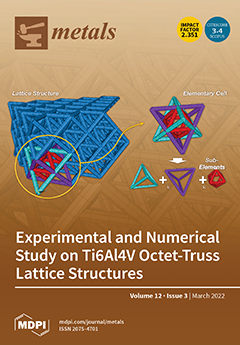To understand and clarify the formation mechanisms and evolution of complex inclusions in Ti-Ca deoxidized offshore structural steel, inclusions in industrial steel were systematically investigated. The number density of total inclusions generally decreased from Ladle Furnace (LF), Vacuum Degassing (VD), Tundish to the final product except for Ti and Ca addition. The major inclusions during the refining process were CaO-Al
2O
3-SiO
2-(MgO)-TiO
x and CaO-Al
2O
3-SiO
2. CaO-Al
2O
3-SiO
2-(MgO)-TiO
x inclusion initially originated from the combination of CaO-SiO
2-(MgO) in refining slag or refractory and deoxidization product Al
2O
3 and TiO
2. With the refining process proceeding and Ca addition, the Al
2O
3 concentration in the CaO-Al
2O
3-SiO
2-(MgO)-TiO
x inclusions gradually dropped while the CaO and TiO
2 concentrations gradually increased. The CaO-Al
2O
3-SiO
2 inclusions originally came from refining slag, existing as 2CaO∙ Al
2O
3∙ SiO
2, and maintained a liquid state during the early stage of LF. After Ca treatment, it was gradually transferred to 2CaO∙ SiO
2 due to Al
2O
3 continuously being reduced by Ca. The liquidus of 2CaO∙ SiO
2 inclusion was higher than that of molten steel, so they presented as a solid-state during the refining process. After welding thermal simulation, CaO-Al
2O
3-SiO
2-(MgO)-TiO
x inclusions were proven effective for inducing intragranular acicular ferrite (IAF) while CaO-Al
2O
3-SiO
2 was inert for IAF promotion. Additionally, Al
2O
3-MgO spinel in multiphase CaO-Al
2O
3-SiO
2-(MgO)-TiO
x inclusion has different formation mechanisms: (1) initial formation as individual Al
2O
3-MgO spinel as a solid-state in molten steel; (2) and it presented as a part of liquid inclusion CaO-Al
2O
3-SiO
2-(MgO)-TiO
x and firstly precipitated due to its low solubility.
Full article





